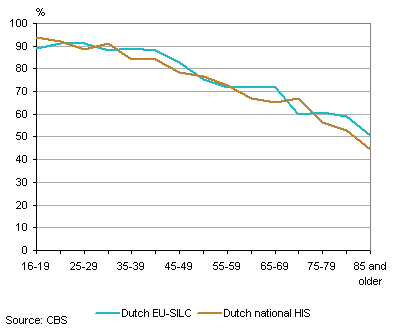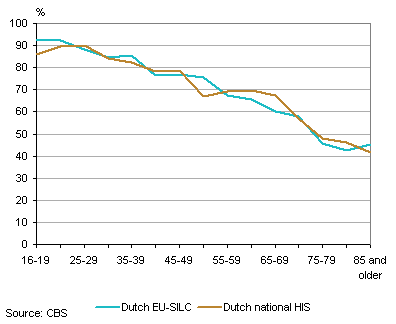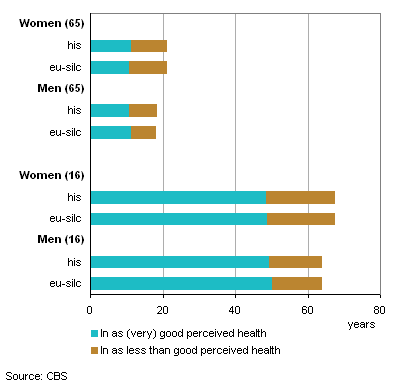Comparison of two data sources for health expectancies

The health expectancies presented in the annual JA EHLEIS country reports are based on the Minumum European Health Module (MEHM) in EU-SILC. This is the case for the Netherlands as well as all other EU member states, allowing to make comparisons with other countries and with the EU at large. However, in the Netherlands and several other countries, in addition to these “European” health expectancies, national time series of health expectancies based on a national survey are published. Statistics Netherlands (known as “CBS”) conducts a health interview survery (HIS) on a yearly basis, and uses these surveys to calculate life expectancy in good perceived health, life expectancy without chronic conditions and life expectancy without disability. These national figures can be found on StatLine, the online database of Statistics Netherlands and are used in several national publications, including the four-yearly public health forecasts (known as ”VTV”) of the National Institute for Public Health and the Environment.
The two series of health expectancies each have an important added value and serve a different purpose. The national set is based on the health survey that includes detailed questions on disability and chronic diseases (used to calculated life expectancies without disability and without chronic morbidity) - as well as detailed questions on life style and other health-related factors. The EU set is part of a broad survey on income and living conditions and includes only the MEHM questions on health and some question on unmet need. The EU-SILC survey, on the other hand, is comparable between the EU countries. But there are also important differences between the surveys in the way the data are collected. The EU-SILC in the Netherlands is not a ‘stand alone’ survey with an own independent sample, but is a follow up survey placed after the fifth wave of the Dutch Labor Force Survey. As a result, the respons rate of the Dutch SILC is low compared to the respons rate of the national HIS. Another difference is the period of observation. Whereas the HIS has a continious observation througout the year, the observation period of EU-SILC is from June until September.
The publication of two series of health expectancies raises the question how comparable the two sources are. To address this question, similar health measures instruments should be present in both surveys. In 2011, the first question of the MEHM on preceived health was part of the national HIS. Using exactly the same phrasing of the question and the same answer categories, this question can be used for a comparison between EU-SILC and HIS.
Figure 1 and 2 show the prevalences of (very) good perceived health by age group and sex, both based on the EU-SILC and HIS. Together with population and mortality data these prevalences form the basis for the calculation of the life expectancy in (very) good perceived health. Both surveys found a total prevalence of 76,4 percent in good or very good perceived health for 2011, for the population aged 16 years and over. While some differences were found for age-specific prevalences, a systematical difference could not be detected. It seems that the results about perceived health of EU-SILC and HIS are very well comparable for 2011. Figure 3 shows the health expectancies resulting from the prevalences in EU-SILC and national HIS, again showing only minor differences.
1. Prevalence of as (very) good perceived health, The Netherlands, 2011, men

2. Prevalence of as (very) good perceived health, The Netherlands, 2011, women

3. Life expectancy and health expectancies at age 16 and age 65, The Netherlands, 2011

The other two MEHM questions could not yet be compared. Although the national survey in 2011 includes a single question on chronic morbidity, this was phrased differently as compared to EU-SILC. The national HIS included the phrase “Also count specific old-age related diseases and symptoms”. Not surprisingly the 2011 prevalences of morbidity were higher in the national HIS. A single question on disability similar to the question in the MEHM was not yet included in the national HIS in 2011. From 2012 onwards also the two other questions of the MEHM are included in the national HIS and will provide in the near future the opportunity to compare all three MEHM-based variants of health expectancy.
J.W. Bruggink (CBS) and W.J. Nusselder (Erasmus MC)